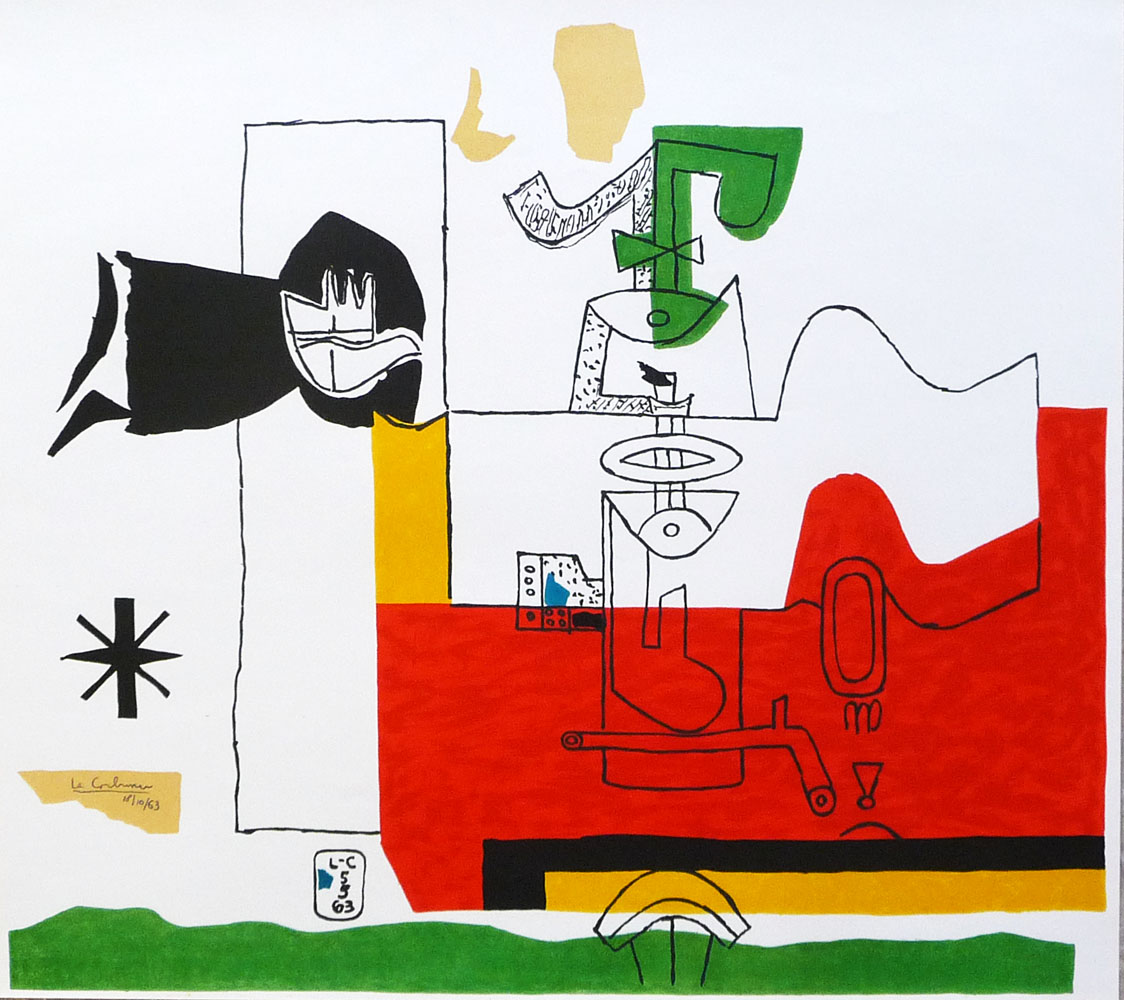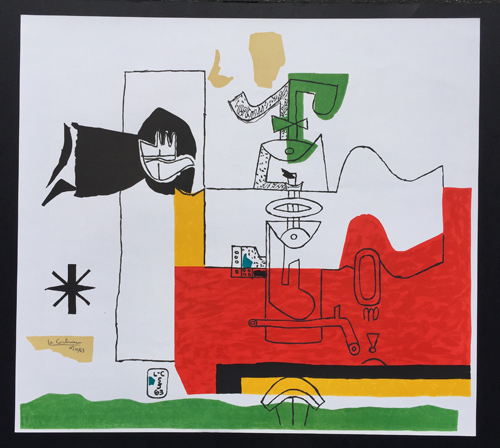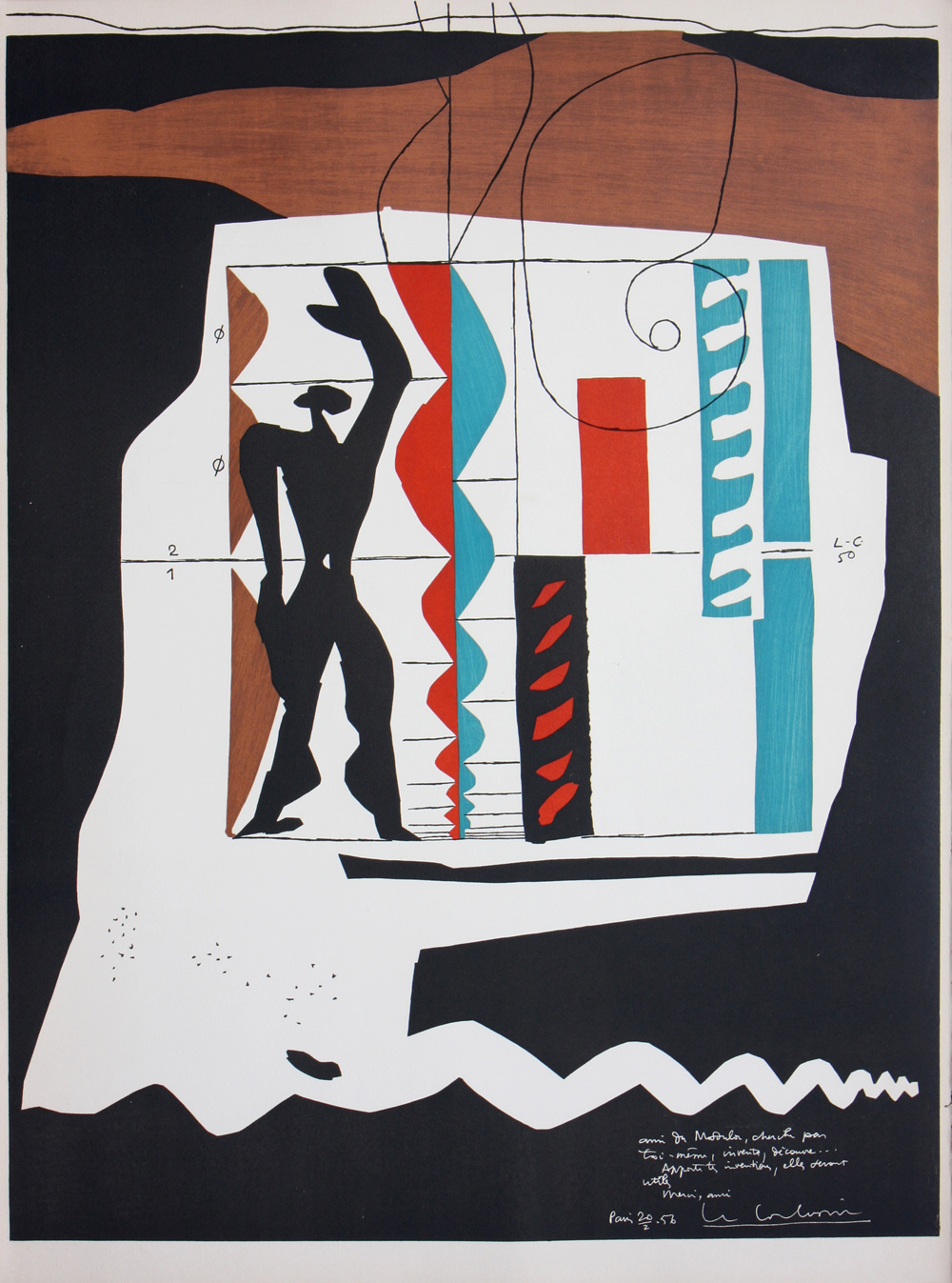Le Corbusier – Totem
Le Corbusier, Totem 1963 is a Limited Edition Le Corbusier Lithograph in colors. Le Corbusier, Totem is signed and dated in the plate. Printed by Mourlot, Paris. Weber Pg 74.
Le Corbusier was a French-Swiss architect, designer, and painter who, along with Frank Lloyd Wright, Walter Gropius, and Mies van der Rohe, is considered one of the most influential architects of the 20th century. Credited with pioneering the Modernist architecture, Le Corbusier popularized open-floor style edifices, the extensive use of concrete in urban buildings, as well as several chair and sofa designs. “Architecture is the masterly, correct and magnificent play of masses brought together in light,” he once explained. “Our eyes are made to see forms in light; light and shade reveal these forms; cubes, cones, spheres, cylinders or pyramids are the great primary forms which light reveals to advantage.” Born Charles-Édouard Jeanneret-Gris on October 6, 1887 in La Chaux-de-Fonds, Switzerland, he studied visual art and, as a painter, was initially drawn to Cubism before rejecting it to cofound the Purism movement. He also helped launch the journal L’Esprit nouveau, wherein he introduced his groundbreaking essay the Five Points of Architecture, which was represented in material form by his building the Villa Savoye in Poissy, France. In 1955, the city of Chandigarh, India commissioned him as its master urban planner, many of the buildings including the city’s Legislative Assembly and High Court, are still in use today. Le Corbusier died on August 27, 1965 in Roquebrune-Cap-Martin, France while swimming in the Mediterranean.
| Title | Totem |
|---|---|
| Medium | Lithograph |
| Year | 1963 |
| Edition | Limited Edition |
| Catalogue Raisonné | Weber Pg 74 |
| Signature | Plate Signed |
| Size | 28.5 x 31.5 (in) 73 x 80.5 (cm) |
| Price | SOLD |
Description
Le Corbusier, Totem 1963 is a Limited Edition Le Corbusier Lithograph in colors. Le Corbusier, Totem is signed and dated in the plate. Printed by Mourlot, Paris. Weber Pg 74.
Le Corbusier was a French-Swiss architect, designer, and painter who, along with Frank Lloyd Wright, Walter Gropius, and Mies van der Rohe, is considered one of the most influential architects of the 20th century. Credited with pioneering the Modernist architecture, Le Corbusier popularized open-floor style edifices, the extensive use of concrete in urban buildings, as well as several chair and sofa designs. “Architecture is the masterly, correct and magnificent play of masses brought together in light,” he once explained. “Our eyes are made to see forms in light; light and shade reveal these forms; cubes, cones, spheres, cylinders or pyramids are the great primary forms which light reveals to advantage.” Born Charles-Édouard Jeanneret-Gris on October 6, 1887 in La Chaux-de-Fonds, Switzerland, he studied visual art and, as a painter, was initially drawn to Cubism before rejecting it to cofound the Purism movement. He also helped launch the journal L’Esprit nouveau, wherein he introduced his groundbreaking essay the Five Points of Architecture, which was represented in material form by his building the Villa Savoye in Poissy, France. In 1955, the city of Chandigarh, India commissioned him as its master urban planner, many of the buildings including the city’s Legislative Assembly and High Court, are still in use today. Le Corbusier died on August 27, 1965 in Roquebrune-Cap-Martin, France while swimming in the Mediterranean.
During World War I Le Corbusier taught at his old school in La-Chaux-de-Fonds, not returning to Paris until the war was over. During these four years in Switzerland, Le Corbusier worked on theoretical architectural studies using modern techniques that would become the foundation for most of Le Corbusier’s architecture, art, sculpture and graphic works for the next ten years.
After moving back to Paris in 1918, Le Corbusier befriended Cubist artists, Fernand Leger and Amedee Ozenfant. Ozenfant encouraged Le Corbusier to paint, and the two began a period of collaboration. Le Corbusier and Ozenfant rejected Cubism as irrational and “romantic,” and together jointly published their manifesto Apres le cubism, establishing a new artistic movement: Purism. Le Corbusier’s art from the Purist period could be characterized as “patient research,” were Le Corbusier untiringly searched for valid form. Le Corbusier created many Still Life themed paintings and artworks during this period.
Le Corbusier, Totem
Le Corbusier prints for sale
Le Corbusier art for sale
Additional information
| Title | Totem |
|---|---|
| Medium | Lithograph |
| Year | 1963 |
| Edition | Limited Edition |
| Catalogue Raisonné | Weber Pg 74 |
| Signature | Plate Signed |
| Size | 28.5 x 31.5 (in) 73 x 80.5 (cm) |
| Price | SOLD |






